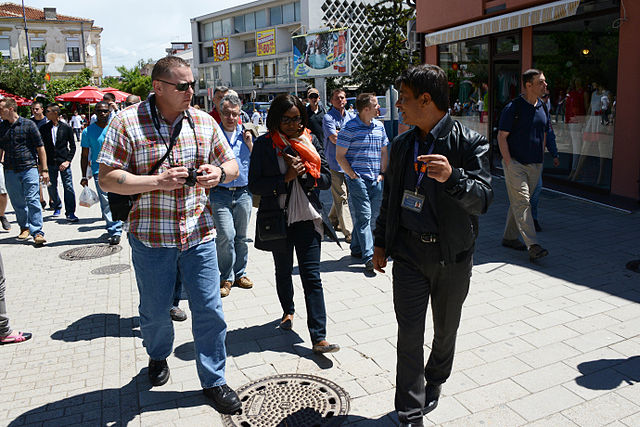 ENEMIGOS, PERO NO TANTO, ESTADOS UNIDOS Y CANADÁ LLENAN A CUBA DE TURISTAS.
ENEMIGOS, PERO NO TANTO, ESTADOS UNIDOS Y CANADÁ LLENAN A CUBA DE TURISTAS.
“Canadá y Estados Unidos encabezan, en ese orden, el ranking de emisores de turistas a Cuba por delante de países europeos, en un momento de apertura oficial a las inversiones extranjeras y a privados locales en la rama” resumió el ministro cubano del Turismo, Manuel Marrero, el estado del sector que especialistas estiman como el más activo de la economía nacional.
Sobre los mercados emisores Canadá, Estados Unidos, Alemania, Francia, Reino Unido, Italia, México y España, en ese orden, encabezan la lista. Marrero aclaró que el año pasado ocurrió una considerable baja en los viajes por vía aérea de los estadounidenses a la Isla a causa del cambio de política de Washington, pero creció el número de cruceristas de esa nacionalidad.
Las mas grandes empresas de cruceros de Estados Unidos no solo mantienen rutas que tocan puertos cubanos en el año que se inicia, sino que una buena parte de ellas han expandido las ofertas que involucran al mercado cubano.
Una puerta crucial que todo parece indicar mantendrá abierta la llamada industria del ocio en Cuba es el de las inversiones extranjeras. El ministro dijo a la prensa local que son 21 las gerencias foráneas que administran instalaciones en Cuba con más de 45.000 habitaciones, el 64 por ciento bajo la modalidad de contratos de administración y comercialización.
El espacio más amplio para los capitales extranjeros en el caso de este país es precisamente la entrega de las gerencias de hoteles a los empresarios de otras nacionalidades y conservando para el Estado cubano la propiedad de los inmuebles.
Agregó que en La Habana prestan actualmente servicio 11 hoteles cinco estrellas y a fines de 2023 deben estar abiertos diez más con esa categoría, anunció. Otro dato brindado por el titular es que los “lazos” con el área privada local también se abren lentamente mediante diversas “modalidades”.
Hoy operan 2.000 restaurantes y 24.217 habitaciones de alquiler en casas privadas cuyos dueños tienen licencia para el trabajo “por cuenta propia”. Todo parece indicar que el turismo es la rama que mas esperanzas levanta en relación con la economía nacional, aún lenta y con diversas asignaturas pendientes en 2019 tanto en el ángulo interno como externo Para la también llamada industria sin chimeneas el ministro describió un plan de desarrollo que abrirá hasta 2013 unas 100.000 habitaciones.
El ministro, citado por la agencia de noticias Prensa Latina, subrayó que “el peso mayor se ejecuta con limitados recursos propios, pero se prioriza la inversión extranjera en el país, como lo demuestran las 5.000 habitaciones de capital mixto ya existentes”. Este año la “meta” de la rama seguirá siendo el arribo de cinco millones de visitantes extranjeros, aplazada en 2017 y 2018.
 ENEMIES, BUT NOT SO MUCH, THE UNITED STATES AND CANADA FILL OUT CUBA OF TOURISTS.
ENEMIES, BUT NOT SO MUCH, THE UNITED STATES AND CANADA FILL OUT CUBA OF TOURISTS.
“Canada and the United States lead, in that order, the ranking of issuers of tourists to Cuba ahead of European countries, at a time of official opening to foreign investments and local private in the branch” summarized the Cuban Minister of Tourism, Manuel Marrero, the state of the sector that specialists estimate as the most active of the national economy.
On the issuing markets Canada, the United States, Germany, France, the United Kingdom, Italy, Mexico and Spain, in that order, top the list. Marrero clarified that last year there was a considerable drop in the air travel of Americans to the Island because of the change in policy in Washington, but the number of cruise passengers of that nationality increased.
The largest cruise companies in the United States not only maintain routes that touch Cuban ports in the year that begins, but a good part of them have expanded the offers that involve the Cuban market.
A crucial door that everything seems to indicate will keep open the so-called leisure industry in Cuba is that of foreign investment. The minister told the local press that there are 21 foreign managers that manage facilities in Cuba with more than 45,000 rooms, 64 percent under the modality of administration and marketing contracts.
The broadest space for foreign capital in the case of this country is precisely the delivery of hotel managers to entrepreneurs of other nationalities and retaining the ownership of real estate for the Cuban State.
He added that 11 hotels are currently serving five stars in Havana and by the end of 2023 ten more hotels should be opened with that category, he announced. Another data provided by the owner is that the “ties” with the local private area also open slowly through various “modalities”.
Today, 2,000 restaurants and 24,217 rooms operate in private homes whose owners are licensed to work “on their own.” Everything seems to indicate that tourism is the branch that hopes the most in relation to the national economy, still slow and with various pending subjects in 2019 both in the internal and external angle For the also called industry without chimneys the minister described a development plan which will open around 100,000 rooms until 2013.
The minister, quoted by the news agency Prensa Latina, stressed that “the greater weight is executed with limited own resources, but priority is given to foreign investment in the country, as demonstrated by the 5,000 mixed capital rooms already existing.” This year the “goal” of the branch will continue to be the arrival of five million foreign visitors, postponed in 2017 and 2018.
Agencies/ San Rafael News/ Internet Photos/ Extractos/ Arnoldo Varona/ www.TheCubanHistory.com
THE CUBAN HISTORY, HOLLYWOOD.





